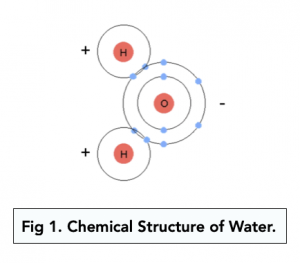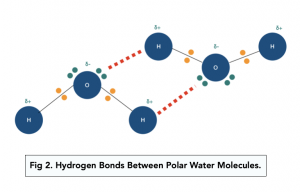Structure of Water (A-level Biology)
Structure of Water
The Biological Importance of Water
- Water makes up about 80% of a cell’s contents. Water has both intracellular (inside cells) and extracellular (outside cells) functions.
- Water has some key functions. Water has unique properties that make it essential for life. These will be explored in the next tutorial.
Structure of Water
- The chemical formula for water is H2O. Water is made up of one atom of oxygen (O) and two atoms of hydrogen (H) and held together by covalent bonds.

- Water is a polar molecule. The electrons that are shared in the covalent bond between oxygen and hydrogen are unevenly distributed. Oxygen attracts the electrons more, giving oxygen a partial negative charge, which then gives the hydrogen atoms a partial positive charge.
- Hydrogen bonds form between water molecules. Because water is a polar molecule, hydrogen bonds form between water molecules. The partially positive hydrogens of one water molecule are electrically attracted to the partially negative oxygen atom of another water molecule. Many of the special properties of water are a consequence of its ability to form hydrogen bonds.

The molecular structure of water is composed of two hydrogen atoms and one oxygen atom, represented as H2O.
The molecular structure of water contributes to its unique properties because the hydrogen bonds between the molecules give water its high surface tension, cohesiveness, and heat-absorbing abilities.
Water molecule polarisation occurs due to the uneven distribution of electrons within the molecule, with the oxygen atom having a slightly negative charge and the hydrogen atoms having a slightly positive charge. This creates a polar molecule, which allows water to dissolve ionic and polar substances.
The high heat capacity of water is significant because it allows water to absorb large amounts of heat without significantly increasing its temperature, helping to regulate the temperatures of living organisms and the environment.
Water and dissolved substances have a relationship where water acts as a solvent, allowing substances such as salts and sugars to dissolve and become evenly distributed in the water.
Water is important in biological processes because it is involved in numerous physiological and metabolic processes, including regulation of body temperature, transportation of nutrients, waste removal, and aiding in chemical reactions.
Water helps maintain homeostasis in living organisms by regulating their body temperature, assisting in the removal of waste, and supporting various chemical reactions necessary for survival.
Water’s polarity contributes to its ability to dissolve polar and ionic substances because the polar nature of water molecules allows them to attract ions and polar molecules, causing them to dissolve and become evenly dispersed in the water.
Water plays a vital role in chemical reactions in living organisms as it acts as a solvent, facilitating the reaction between different substances, and also participates in the reaction as a reactant or product.
Temperature changes can have an impact on the structure of water as heating can cause the water molecules to move faster and increase their kinetic energy, leading to changes in the hydrogen bonding between the molecules and the ability of water to dissolve substances.





Still got a question? Leave a comment
Leave a comment